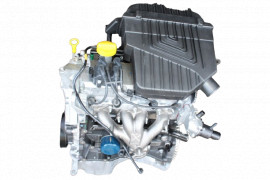Discovering the Inner Workings of a Compact Vehicle's Engine System
As chauffeurs, we usually take for given the complex procedures that happen within the boundaries of our lorry's engine system. The small yet complex machinery that thrusts us onward is a wonder of engineering accuracy and coordination. From the regulated surges in the combustion chamber to the meticulous timing of fuel injection, every part plays an essential role in the smooth operation of the engine. In this expedition of a portable car's engine system, we will certainly unwind the internal operations of this mechanical symphony, dropping light on the secrets that drive us forward on our everyday journeys.
Burning Process Summary
The burning procedure in a portable car's engine system is an essential mechanism that effectively transforms gas into power to power the vehicle. This process happens within the burning chamber of the engine, where gas and air mix, ignite, and create regulated surges. The combustion process contains 4 major stages: intake, exhaust, compression, and power.
Throughout the intake phase, the piston moves downward, attracting in a mix of air and gas into the burning chamber. The next phase, compression, involves the piston relocating upward, compressing the air-fuel blend to increase its strength. Subsequently, in the power phase, the stimulate plug ignites the compressed combination, leading to a quick growth of gases that compels the piston back down. This downward movement produces the power required to drive the vehicle. In the exhaust phase, the burned gases are eliminated from the combustion chamber with the exhaust shutoff, preparing the chamber for the following cycle. This cyclic combustion procedure is basic to the operation of a small lorry's engine system, guaranteeing effective power conversion for propulsion.
Piston and Cylinder Interaction

The piston's exact fit within the cyndrical tube is crucial for keeping ideal compression and stopping energy loss during combustion. Tight clearances between the piston and cylinder walls guarantee effective sealing, allowing the piston to move efficiently without permitting gases to leak past. Proper lubrication is also vital to reduce rubbing and put on in between these elements, boosting durability and performance.
Additionally, the style and materials used in manufacturing the piston and cylinder influence engine efficiency and durability. Modern engines often use lightweight yet resilient materials like aluminum alloys for pistons and cylinder linings to minimize inertia and improve thermal efficiency. On the whole, the harmonious communication between the piston and cylinder is basic to the engine's functionality and total performance.
Fuel Shot System Performance
Gas injection systems in portable automobile engines play a crucial duty in exactly delivering gas to the burning chamber for regulated and efficient ignition. The gas injection system functions by infusing fuel into the burning chamber at the ideal minute during the engine's procedure (opel corsa engine). This precise timing makes sure that the fuel blends equally with the air for proper combustion, resulting in improved gas performance and lowered exhausts
There are largely two kinds of gas shot systems used in compact lorry engines: port gas shot (PFI) and direct gas injection (DFI) PFI systems infuse gas into the consumption port prior to the intake valve, while DFI systems infuse fuel directly right into the burning chamber. Both systems have their benefits, with DFI providing much better gas atomization and PFI offering a much more economical remedy.
Understanding Engine Cooling Devices
Effective procedure of a small automobile's engine counts greatly on the performance of read this article its cooling devices. Engine cooling is vital to protect against getting too hot, which can lead to major damages and reduced efficiency. The air conditioning system in a compact automobile commonly contains several components interacting to regulate the engine temperature level. One important part is the radiator, which utilizes coolant to absorb heat from the engine. As the warm coolant streams via the radiator, it releases heat into the air, cooling down prior to going back to the engine. The water pump circulates the coolant with the engine and radiator, making certain a consistent flow to regulate temperature. Additionally, the thermostat helps regulate the coolant circulation to preserve optimum engine temperature level. Some automobiles likewise have cooling fans that turn on when added air conditioning is required, such as during rush hour or heat. Understanding these engine cooling mechanisms is crucial for maintaining the efficiency like this and long life of a portable automobile's engine system.

Exhaust System Components Explained
The optimal functioning of a portable vehicle's engine cooling devices depends on a corresponding system known as the exhaust system, which consists of different vital components for making sure reliable emissions and engine efficiency. The exhaust manifold collects exhaust gases from the engine's courses and cylinders them to the catalytic converter.
One critical element of the exhaust system is the oxygen sensing unit, which keeps track of the oxygen degrees in the exhaust gases to help manage gas usage and ensure ideal engine performance. opel corsa engine. Furthermore, the resonator may exist in some exhaust systems to reduce noise degrees. Generally, the exhaust system plays a vital function in maintaining engine effectiveness, reducing damaging exhausts, and ensuring a quieter driving experience for portable vehicle owners

Final Thought
In conclusion, the small vehicle's engine system is a complicated mix of components that work with each other to help with the burning procedure, convert fuel right into power, and expel waste gases. Comprehending the inner functions of the engine system, consisting of the piston and cylinder interaction, gas injection system, engine cooling systems, and exhaust system elements, is vital for keeping optimum efficiency and performance of the vehicle.
The burning procedure in a compact car's engine system is a critical system that effectively converts gas into energy to power the car.Fuel injection systems in small automobile engines play an important duty in precisely providing fuel to the burning chamber for effective and controlled ignition.There are mostly 2 kinds of gas shot systems used in compact car engines: port fuel shot (PFI) and straight gas injection (DFI) Understanding these engine air conditioning devices is crucial for keeping the efficiency and long life of a useful content compact vehicle's engine system.
The ideal functioning of a small car's engine cooling devices depends on a corresponding system understood as the exhaust system, which makes up various important elements for guaranteeing efficient exhausts and engine efficiency.